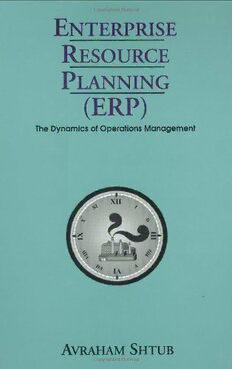
Enterprise resource planning (ERP): the dynamics of operations management PDF
161 Pages·1999·2.503 MB·English
Most books are stored in the elastic cloud where traffic is expensive. For this reason, we have a limit on daily download.
Preview Enterprise resource planning (ERP): the dynamics of operations management
Description:
Increasingly, corporations are recognizing the strategic role of the operations function. These organizations are discovering that a focus on customer needs is effective only if the operations function is designed and managed to meet those needs. From acquiring raw materials to fabricating parts, to assembling products, to customer delivery, a total systems perspective can enable us, in the ideal, to fashion an operations function like the inner workings of a finely tuned machine. Today that operation can be fine-tuned by using modern information systems. This text presents an enterprise-wide examination of implementing a modern information system in all business processes of a modern business enterprise. Enterprise Resource Planning software systems provide comprehensive management of financial, manufacturing, sales, distribution and human resources across the enterprise. The ability of ERP systems to support data "drill down" and to eliminate the need to reconcile across functions is designed to enable organizations to compete on the performances of the entire supply chain. Until now, there has not been an effective presentation of the dynamics of operation systems illustrating how ERP systems are used. This book and the accompanying software should fill this need. It has been written with an emphasis on manufacturing firms, but the principles it demonstrates are transferable to other types of operation systems. With this in mind, service operations issues have been included as a part of the problems at the end of each chapter. The book and the accompanying software have been designed for use in academic and executive programs aimed at helping researchers, students, and professionals to understand how integrated operational systems work. In terms of the book's use as a course book, a course on planning and control systems would probably be the ideal place in business school settings. Some basic understanding of operating systems is needed by the reader. In an industrial engineering school, the book may give students their first introduction to business issues such as market demand and supplier relationships.
See more
The list of books you might like
Most books are stored in the elastic cloud where traffic is expensive. For this reason, we have a limit on daily download.
